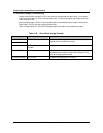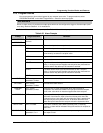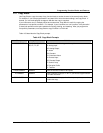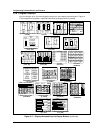
Programming Function Blocks and Features
Video Recorder – User Manual 143
4.13 Program Alarms
You can program an alarm to be triggered by any extreme input value. To program alarms, select
“PROGRAM ALARMS” on the Main Program Menu. Select an alarm to program.
REFERENCE
When an alarm occurs, it produces an output pulse which can be configured to trigger a discrete output (such
as a relay). Refer to Section 4.11 for instructions.
Table 4-50 describes the Alarm prompts. See Table 4-2 for additional prompts.
Table 4-50 Alarm Prompts
Prompt Range/Selections Definition
ON STATE
OFF STATE
See Table 4-3 for
choices.
Enter labels for on and off states of alarm
ALARM ACTION HIGH
Alarm when input value ≥ set point value.
LOW
Alarm when input value ≤ set point value.
DEV Deviation. Alarm when input value deviates above or below compare
point value by an amount ≥ set point value.
HDEV High deviation
LDEV Low deviation
HRATE
High Rate. Alarm when input value increases at rate ≥ set point
value, in units per minute. Negative rate set points are processed as
positive values. May take up to 30 seconds to activate.
LRATE
Low Rate. Alarm when input value decreases at rate ≥ set point
value, in units per minute. Negative rate set points are processed as
positive values. May take up to 30 seconds to activate.
NONE No alarm action.
INPUT OFF, analog
parameter, number
Input source monitored by alarm.
SETPOINT OFF, analog
parameter, number
Point at which alarm occurs.
COMPARE
POINT
OFF, analog
parameter, number
DEV type only. It is the point against which the input point is
compared. The difference between the input point and the compare
point is the value which is measured against the alarm set point.
HYSTERESIS OFF or number Hysteresis affects only the point at which an alarm clears. A high
alarm will clear when the input is less than the set point minus the
hysteresis value. A low alarm will clear when the input is greater than
the set point plus the hysteresis value. A deviation alarm will clear
when the input is less than the set point minus the hysteresis value.
DELAY TIME OFF or number If the alarm condition clears before the delay time (in seconds)
expires, no alarm will be indicated. Delay time must be in multiples of
scan time.
SAMPLE HOLD OFF, discrete
parameter, 0 or 1
When this parameter level = 1, the alarm processing is disable and
the output is held.


















